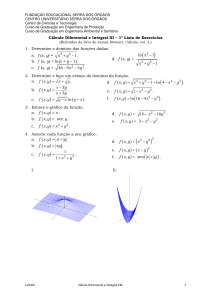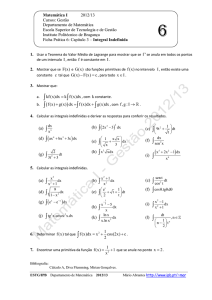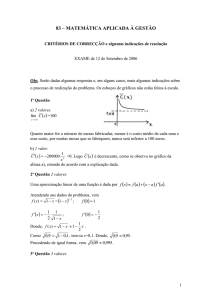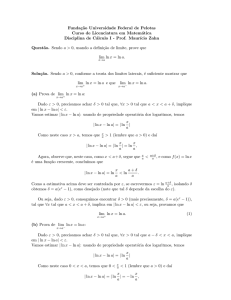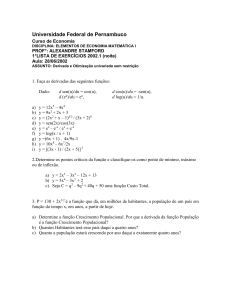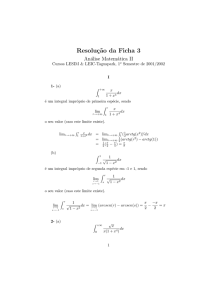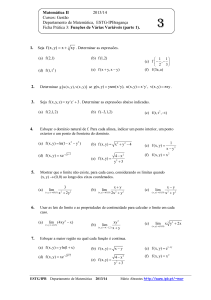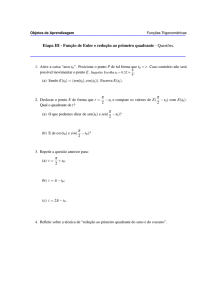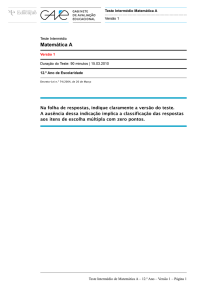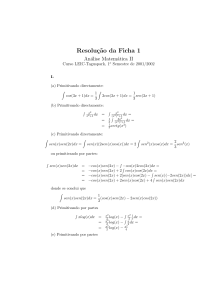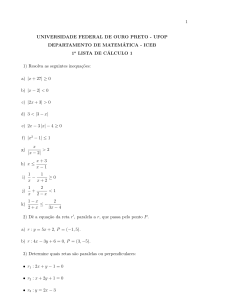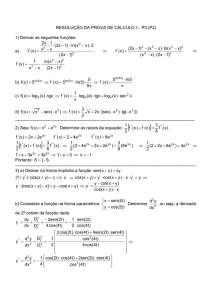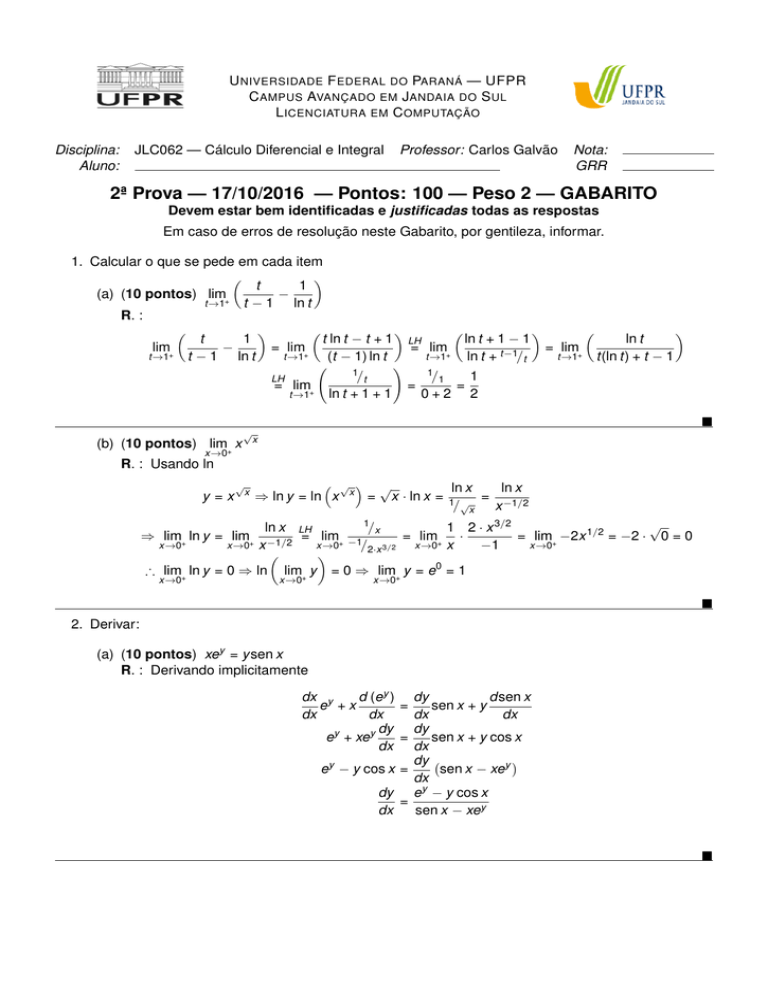
U NIVERSIDADE F EDERAL DO PARANÁ — UFPR
C AMPUS AVANÇADO EM J ANDAIA DO S UL
L ICENCIATURA EM C OMPUTAÇÃO
Disciplina:
Aluno:
JLC062 — Cálculo Diferencial e Integral
Professor: Carlos Galvão
Nota:
GRR
2ª Prova — 17/10/2016 — Pontos: 100 — Peso 2 — GABARITO
Devem estar bem identificadas e justificadas todas as respostas
Em caso de erros de resolução neste Gabarito, por gentileza, informar.
1. Calcular o que se pede em cada item
(a) (10 pontos) lim+
t→1
t
1
−
t − 1 ln t
R. :
lim
t→1+
t
1
−
t − 1 ln t
= lim+
t→1
t ln t − t + 1
(t − 1) ln t
1/
t
!
LH
= lim+
√
(b) (10 pontos) lim+ x
= lim+
t→1
ln t + 1 + 1
t→1
LH
=
1/
1
0+2
ln t + 1 − 1
ln t + t−1/t
=
= lim+
t→1
ln t
t(ln t) + t − 1
1
2
x
x→0
R. : Usando ln
√
y =x
x
⇒ lim+ ln y = lim+
x→0
x→0
√ ⇒ ln y = ln x
ln x LH
= lim+
x→0
x −1/2
∴ lim+ ln y = 0 ⇒ ln
x→0
lim y
x→0+
x
=
1/
√
x · ln x =
x
−1/ 3/2
2·x
= lim+
x→0
ln x
1/√
x
=
ln x
x −1/2
√
1 2 · x 3/2
·
= lim+ −2x 1/2 = −2 · 0 = 0
x→0
x
−1
= 0 ⇒ lim+ y = e0 = 1
x→0
2. Derivar:
(a) (10 pontos) xey = ysen x
R. : Derivando implicitamente
dx y
d (ey ) dy
dsen x
e +x
=
sen x + y
dx
dx
dx
dx
dy
y
y dy
e + xe
=
sen x + y cos x
dx dx
dy
ey − y cos x =
sen x − xey
dx
dy ey − y cos x
=
dx
sen x − xey
(b) (10 pontos) y = (cos t)t
R. : Usando ln
ln y = ln (cos t)t = t(cos t)
Derivando
1 dy dt
d(cos t)
=
cos t + t
y dt
dt
dt
= cos t − tsen t
dy
= (cos t)t (cos t − tsen t) = (cos t)t+1 − tsen t(cos t)t
dt
2x
(c) (10 pontos) f (x) = tanh(1 + e )
R. : Regra da Cadeia
f 0 (x) = sech 2 (1 + e2x ) · (2e2x ) =
1
senh (1 + e2x )
2
· (2e2x ) = 2
ex
senh (1 + e2x )
2
(d) y =
(x 2
(2x +
+
1)4
1)3 (3x
(Derivação Correta (10 pontos) Resposta final com fração simplificada corre-
− 1)5
tamente (15 pontos) )
R. : Usando ln
(x 2 + 1)4
ln y = ln
(2x + 1)3 (3x − 1)5
!
= ln (x 2 + 1)4 − ln (2x + 1)3 (3x − 1)5
= ln (x 2 + 1)4 − ln(2x + 1)3 − ln(3x − 1)5
= 4 ln (x 2 + 1) − 3 ln(2x + 1) − 5 ln(3x − 1)
Derivando
1 dy
2x
2
3
=4 2
−3
−5
y dx
x +1
2x + 1
3x − 1
8x (2x + 1) − 6 x 2 + 1
=
x2
+ 1 (2x + 1)
−
15
3x − 1
16x 2 + 8x − 6x 2 − 6 (3x − 1) − 15 x 2 + 1 (2x + 1)
=
x 2 + 1 (2x + 1) (3x − 1)
3 + 24x 2 − 18x − 10x 2 − 8x + 6 − 15 2x
30x
3 + x 2 + 2x + 1
=
2
x + 1 (2x + 1) (3x − 1)
=
⇒
−x 2
x2
− 56x − 9
+ 1 (2x + 1) (3x − 1)
(x 2
1)4
−x 2
dy
+
− 56x − 9
=
·
=
dx (2x + 1)3 (3x − 1)5 x 2 + 1 (2x + 1) (3x − 1)
−(x 2 + 1)3 x 2 + 56x + 9
(2x + 1)4 (3x − 1)6
3. (15 pontos) Encontre a linearização local de f (x) = ex/2 próximo a x = 0
ex/2
1
1
x x +2
R. : f (x) = ex/2 ⇒ f 0 (x) =
. f (0) = 1 e f 0 (0) = . Portanto, f (x) ≈ (x − 0) + 1 = 1 + =
2
2
2
2
2
4. (cada item 05 pontos) A meia vida do césio-137 é 30 anos. Tendo uma amostra inicial de 100mg.
(a) Encontre a massa após t anos (fórmula m(t) = m(0)ekt – eln 2t = 2t )
2
1
1
....
R. : A cada 30 anos, reduz pela metade. Q(0) = 1, Q(30) = , Q(2 · 30) =
2
2
1
− ln 2
Achar k m(0) = 100, m(30) = 50 = 100e30k ⇒ e30k = ⇒ 30k = − ln 2 ⇒ k =
.
2
30
−(ln 2)·t/
−t
30
Fórmula: m(t) = 100e
= 100 · 2 /30 , pois e−(ln 2)·t = 2−t
(b) Quanto restará após 100 anos?
R. : m(100) = 100 · 2−100/30 = 9,92126g
(c) Depois de quanto tempo restará apenas 1 mg?
t
R. : 1 = 100 · 2−t/30 ⇒ 10−2 = 2−t/30 ⇒ −2 = log(2−t/30 ) = − log 2
30
2 · 30
60
⇒t =
=
= 199,31569 anos
log 2
log 2
5. Para a função f (x) =
x 5 − 30x 3 + 2
indique
5
(a) (05 pontos) Os pontos Críticos, classificando-os como máximos locais, mínimos locais ou
inflexões
√
√
R. : Derivada x 4 − 18x 2 = x 2 (x 2 − 18). Críticos: x = 0 inflexão, x = 18, mínimo e x = − 18,
máximo
(b) (05 pontos) Os intervalos de Crescimento e descrescimento
R. : Estudo de Sinais:
√
√ √ √
Decrescimento: − 18, 18 , Crescimento: −∞, − 18 ∪
18, ∞ .
(c) (10 pontos) As concavidades da função e todas as inflexões
R. : Derivada segunda: 4x 3 − 36x = 4x(x 2 − 9) = 4x(x + 3)(x − 3). Inflexões: −3, 0, 3.
Pelo estudo de sinais
Concavidade para cima: (−3, 0) ∪ (3, ∞)
Concavidade para baixo: (−∞, −3) ∪ (0, 3)

